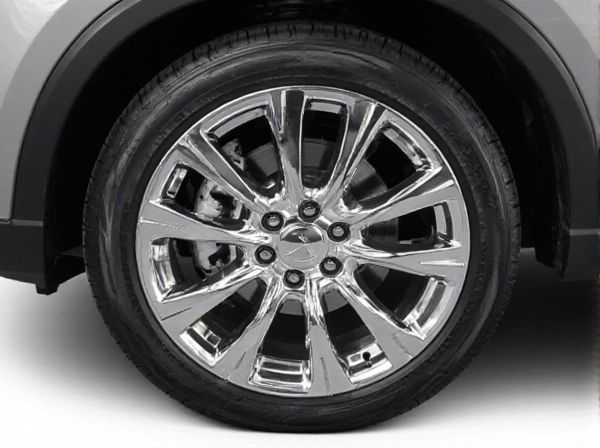
Photo illustration: Chrome vs Powder Coated
Chrome finishes provide a shiny, reflective surface that enhances durability and resists corrosion, making them ideal for decorative automotive parts and plumbing fixtures. Powder coating offers a thicker, more uniform protective layer that is highly resistant to chipping, fading, and weather damage, perfect for outdoor furniture and industrial equipment. Choosing between chrome and powder-coated finishes depends on your desired aesthetic, durability needs, and exposure to environmental factors.
Table of Comparison
| Feature | Chrome Wheels | Powder Coated Wheels |
|---|---|---|
| Finish | Glossy, mirror-like shine | Matte or glossy, durable finish |
| Durability | Prone to peeling and rust | Highly resistant to chipping and corrosion |
| Maintenance | Requires frequent polishing and care | Low maintenance, easy cleaning |
| Cost | Generally more expensive | More affordable option |
| Weight | Heavier due to plating | Lighter coating process |
| Customization | Limited to chrome finish | Wide color and texture options |
Introduction: Understanding Chrome and Powder Coating
Chrome plating involves electroplating a thin layer of chromium onto a metal surface, providing a shiny, corrosion-resistant finish commonly used in automotive and decorative applications. Powder coating applies a dry powder that is electrostatically charged and cured under heat to form a durable, protective layer resistant to chipping, fading, and corrosion, widely favored for industrial and outdoor metal objects. Both methods enhance metal durability and aesthetics but differ significantly in their application process, texture, and long-term performance characteristics.
What is Chrome Plating?
Chrome plating is a metal finishing process that involves electroplating a thin layer of chromium onto a metal or plastic surface to enhance durability, corrosion resistance, and aesthetic appeal. The technique creates a shiny, mirror-like finish and provides a protective barrier against rust and wear. Chrome plating is commonly used in automotive parts, plumbing fixtures, and decorative hardware due to its combination of strength and visual appeal.
What is Powder Coating?
Powder coating is a dry finishing process that involves applying a fine powder made of resin and pigment onto a metal surface, which is then cured under heat to form a durable, protective layer. This coating offers superior resistance to corrosion, chipping, and fading compared to traditional chrome plating. The environmentally friendly, VOC-free technique provides a wide range of color options and a uniform, smooth finish ideal for automotive, industrial, and consumer products.
Durability Comparison: Chrome vs Powder Coated
Chrome finishes offer excellent durability with strong resistance to corrosion, scratches, and tarnishing, making them suitable for high-traffic or outdoor use. Powder coated surfaces provide superior toughness against chipping, fading, and weather exposure due to their thick, even protective layer applied through a curing process. Compared to chrome, powder coating typically delivers enhanced long-term durability, especially in harsh environmental conditions or heavy-use applications.
Aesthetic Appeal: Shine, Color, and Texture Differences
Chrome finishes offer a highly reflective, mirror-like shine that enhances brightness and creates a sleek, modern aesthetic, while powder coating provides a more matte to semi-gloss finish available in a wide spectrum of colors for greater customization. Chrome surfaces tend to be smooth and cool to the touch, emphasizing a polished metallic texture, whereas powder-coated finishes offer varied textures from smooth to textured, adding tactile depth. The choice between chrome and powder coating significantly affects visual impact, with chrome emphasizing high gloss and metallic brilliance and powder coating delivering versatile color options and durable surface finishes.
Cost Analysis: Chrome Plating vs Powder Coating
Chrome plating typically incurs higher upfront costs due to its labor-intensive electroplating process and the use of hazardous chemicals, requiring specialized disposal methods that increase expenses. Powder coating offers a more cost-effective alternative with lower material costs, faster application times, and minimal environmental compliance expenses, making it suitable for large-scale production. Over the long term, powder coating reduces maintenance and refinishing costs thanks to its superior corrosion resistance and durability compared to chrome plating.
Maintenance and Cleaning Requirements
Chrome surfaces require regular cleaning to prevent tarnishing and rust, often needing specialized metal polishes and soft cloths to maintain their shine. Powder coated finishes offer greater durability and resist chipping, fading, and scratching, allowing for simpler maintenance with mild soap and water. Both finishes benefit from prompt removal of dirt and contaminants to preserve their appearance and longevity.
Environmental and Health Impacts
Chrome plating involves toxic chemicals like hexavalent chromium, posing significant health risks including respiratory issues and skin irritation, while its environmental impact includes hazardous waste contamination. Powder coating uses non-toxic, solvent-free powders, resulting in lower volatile organic compound (VOC) emissions and reduced environmental pollution. The powder coating process also allows for recycling overspray, minimizing waste and promoting eco-friendliness compared to traditional chrome plating.
Application Suitability: Best Uses for Each Finish
Chrome finish offers superior corrosion resistance and a reflective, high-gloss appearance, making it ideal for automotive parts, plumbing fixtures, and decorative hardware exposed to moisture. Powder coating provides a durable, matte to glossy finish with excellent abrasion resistance and color variety, suited for outdoor furniture, industrial equipment, and metal appliances requiring long-lasting protection against weather and chemicals. Choosing between chrome and powder coating depends on the specific environmental exposure, desired aesthetic, and maintenance requirements of the application.
Final Verdict: Choosing Between Chrome and Powder Coated
Chrome offers a highly reflective, durable finish that resists corrosion and enhances aesthetics, making it ideal for automotive parts and decorative applications. Powder coating provides a thicker, more flexible protective layer available in a wide range of colors and textures, excellent for outdoor furniture and industrial equipment requiring long-term wear resistance. The final choice depends on the specific application demands: chrome is best for high-gloss, stylish surfaces with moderate durability needs, while powder coating excels in heavy-duty, color-customizable protection.
 caratoz.com
caratoz.com